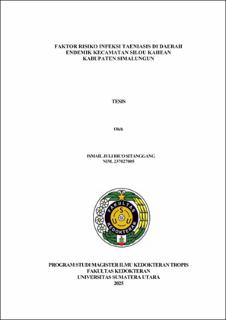Faktor Risiko Infeksi Taeniasis di Daerah Endemik Kecamatan Silou Kahean Kabupaten Simalungun
Risk Factors for Taeniasis Infection in Endemic Area of Silou Kahean District Simalungun Regency

Date
2025Author
Sitanggang, Ismail Juli Rico
Advisor(s)
Darlan, Dewi Masyithah
Ramayani, Oke Rina
Metadata
Show full item recordAbstract
Silou Kahean Subdistrict in Simalungun Regency is an endemic area for taeniasis, characterized by poor community sanitation and hygiene, as well as a high prevalence of pig farming within household environments. This study aimed to analyze the influence of environment factors on the prevalence of taeniasis in the region. An analytical survey design with a cross-sectional approach was used, involving 270 respondents selected based on the Isaac and Michael table. The prevalence of taeniasis infection was found to be 5.9%. Bivariate analysis showed that variables significantly associated with taeniasis infection included pig ownership (p = 0.002; POR = 5.513; 95% CI: 1.953–15.560), pig-rearing practices (p = 0.0001), pigpen sanitation (p = 0.002), consumption of pig liver (p = 0.017), personal hygiene (p = 0.027), and health status based on a history of expelling tapeworm segments (p = 0.0001; POR = 181.500; 95% CI: 33.697–977.608). In contrast, individual characteristics such as gender, age, education, and occupation did not show a significant relationship (p-value > 0.05). Multivariate analysis using multiple logistic regression revealed that the most influential variables were health status (p = 0.0001; Exp(B) = 1136.852) and pig ownership (p = 0.003; Exp(B) = 13.213). These findings indicate that the risk of taeniasis infection significantly increases among individuals with a prior history of infection and among households that raise pigs. The study concludes that taeniasis infection in Silou Kahean Subdistrict is influenced by prior infection history and household pig-rearing practices. Taeniasis control efforts should focus on health education, improving pigpen sanitation, and promoting more hygienic and confined pig-rearing practices.
